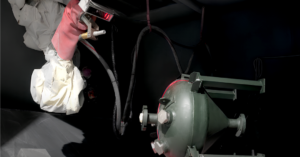table of contents
- Heading 1
- Heading 1
- Heading 1
share this
Robots were used in the automotive industry since the 1970s and today, it is no surprise to see machines in its car factories for manufacturing and logistics.
How has automation transformed automobile factories? As technology processes, machines and robots get more sophisticated. Robots are here to stay and they will get smaller and more flexible. The improvements in robotics allow better collaboration between human operators and machines. The International Federation of Robotics indicated that the automotive industry is still the biggest customer industry for robots in 2019, with 30% of total installations. [1]
In this 3-part series, we will dive deep into three automotive manufacturers, Mercedes Benz, Tesla and Toyota and analyse how successful in integrating robots into their assembly lines around the world.
Case Study 1:Mercedes Benz’s Factory 56
Can luxury cars be automated? Let’s analyse Mercedes Benz, the second-largest manufacturer of luxury cars and its Factory 56 at Sindelfingen, Germany.
What Worked: Synergy Between Machine and Man
According to an MIT research in conjunction with Mercedes-Benz and BMW, teams that involve both robots and humans were up to 85% more productive than working with only humans or having full automation. [2]
To harness the synergy between robots and man, Mercedes-Benz came up with “robot farming”. The German automotive maker partnered up with KUKA AG to develop robots that allows robots and people to work together directly in production, without the need of a protective shield. Back in 2012, they were one of the early adopters to use collaborative robots, also known as cobots, in the manufacturing space. [3] These robots are lightweight and flexible, allowing the human to work alongside it safely. Overall, human-robot cooperation leads to an optimised production process.

Robots are used heavily on car assembly lines
Source: Product Hunt at GIPHY https://gph.is/1Sj2LHA
Other than cobots, in Factory 56, driverless transport systems (AGVs), also known as “TecLines”, are used to substitute the traditional assembly line at specific stages of production. This allows the vehicle to stay stationary at stages to make automation simpler. When the car frame is not moving, robots can be easily programmed for fixed, repetitive tasks, such as installing a sliding roof. On top of that, expansion of selected assembly areas is possible, without having a massive overhaul of the factory building infrastructure.
What Didn’t: Unable to Scale for Customised Products
Despite having its reputation for manufacturing some of the finest cars, Mercedes-Benz experiences problems with automation in its assembly line in Germany.
The greatest limitation of robots is its inability to adapt efficiently to customisation. Although robots are great with repeatable and stationary tasks, they are terrible with adapting. According to Mercedes-Benz’s head of production, Markus Schaefer, robots are unable to deal with the degree of individualization and the many variants that they face today. [4]

Customisations on a Mercedes-Benz car makes it difficult to automate
Source: GIPHY https://giphy.com/gifs/mercedes-hPyvpMYDBXCbC
As for Mercedes-Benz, they plan to add 30 more models, including 10 brand new designs, and offer customisations on individual cars such as leather material, bamboo trim, interior fragrances and also attaching lights to the front Mercedes star. [5] With such a wide range of customisations that require artisanal care, it is no wonder that they struggle with automating the assembly line with the current technology.
In comparison, humans are able to adapt to these minute changes in a fraction of a second. “When we have people and machines co-operate, such as a person guiding a part-automatic robot, we’re much more flexible and can produce many more products on one production line.”, Markus Schaefer said, “ The variety is too much to take on for the machines.”
Key Takeaway
[1] Automotive factories are evolving. To harness the best results from robots, Mercedes-Benz decided to allow robots to work with humans, especially with the latest collaboration robots. Other than robots on the assembly lines, driverless vehicles are also deployed for logistics transport within the factory.
However, for luxury brands like Mercedes-Benz, the customization required for their cars are too complex for a simple robot with the current state of the art. More research for better technology needs to be done to maximize the use of robots in this industry.




